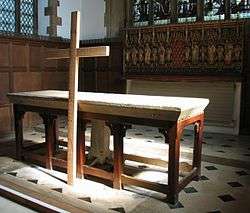Stripping of the Altar
The Stripping of the Altar is a ceremony carried out in the earlier form of the Roman Rite at the end of Mass of the Lord's Supper on Maundy Thursday. It is still carried out in many Anglican and Lutheran[1] churches on Maundy Thursday. All altars in the church, except for the Altar of Repose, are stripped.
In the present form of the Roman Rite, as revised in 1955, there is no ceremony of stripping the altar. At a suitable time after the Mass the altar is stripped, usually by the sacristan, and crosses are removed from the church, if possible.[2] There is no Mass on Good Friday or Holy Saturday, the next one being that of the Easter Vigil. On Good Friday, a white cloth is placed on the altar for the last part of the Celebration of the Passion of the Lord,[3] after the conclusion of which the altar is stripped, again privately, except that the Cross remains on the altar with two or four candlesticks.[4]

The form of the Roman Rite in use immediately before the reform of the Easter Triduum ceremonies by Pope Pius XII in 1955 had a formal ceremony of stripping the altar as a conclusion of the Holy Thursday Mass, which was then celebrated in the morning. After removing the ciborium from the high altar to the altar of repose, the priest, accompanied by the other ministers, went to the sacristy, where he took off his white Mass vestments and donned a violet stole. Then, with the other ministers, he removed the altarcloths, vases of flowers, antependium and all other ornaments then customarily placed on the altar. Unlike present usage, the altar cross and candlesticks were left on the altar. This was done to the accompaniment of Psalm 21 (Vulgate) (Deus, Deus meus) preceded and followed by the antiphon "Diviserunt sibi vestimenta mea: et super vestem meam miserunt sortem" (They divided my clothes among them and cast lots for my garment).[5]
In earlier centuries, the altars were in some churches washed with a bunch of hyssop dipped in wine and water. Augustine Joseph Schulte says that this was done "to render them in some manner worthy of the Lamb without stain who is immolated on them, and to recall to the minds of the faithful with how great purity they should assist at the Holy Sacrifice and receive Holy Communion." He adds that the ceremony was intended as homage offered to Jesus in return for his humbly washing the feet of his disciples,[5] the ceremonial commemoration of which was, before 1955, carried out separately from the Mass and stripping of the altar
Eamonn Duffy alluded to this ceremony in The Stripping of the Altars a history of popular religion in pre-Reformation England.
See also
References
- ↑ Living Lutheran, The Three Days: traditions of Maundy Thursday, Good Friday and the Vigil of Easter, http://www.elca.org/en/Living-Lutheran/Ask-a-Pastor/2013/10/~/link.aspx?_id=8A91118FE3E341839E13E7444A33CBF6&_z=z
- ↑ Roman Missal, Thursday of the Lord's Supper, 41
- ↑ Roman Missal, Friday of the Passion of the Lord (Good Friday), 22
- ↑ Roman Missal, Friday of the Passion of the Lord (Good Friday), 33
- 1 2
 Herbermann, Charles, ed. (1913). "Stripping of an Altar". Catholic Encyclopedia. New York: Robert Appleton Company.
Herbermann, Charles, ed. (1913). "Stripping of an Altar". Catholic Encyclopedia. New York: Robert Appleton Company.